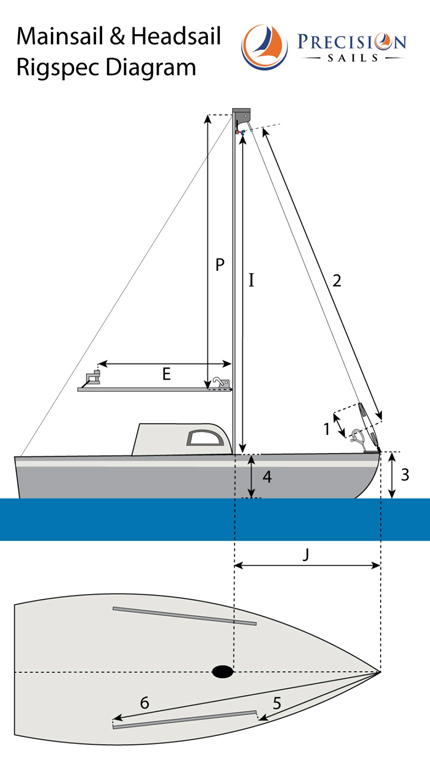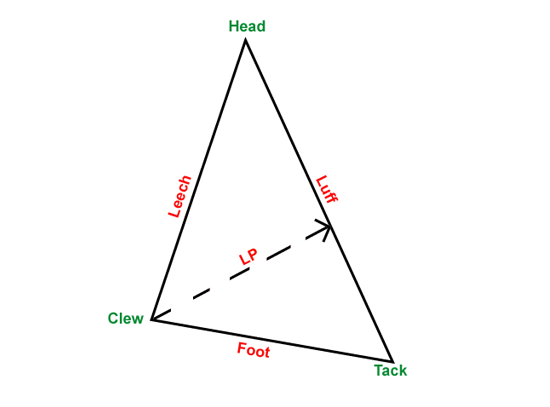How to Measure a Sail
When you are ordering a new sail, you will need to provide some measurements. It is best to take your old sail to the loft if it is local or have their rep to come and see the boat and the sails. Sailmakers use certain letters to refer to the parts that needs to be measured. For spinnakers, there are other measurements to take. The backstay is not usually measured; however, it is important that the leech of the mainsail does not touch it when tacking/jibing.
However, for the mainsail and genoa, these letters represent:
P (maximum luff) is the distance from the top of the boom to the bottom of the black band at the top of the mast. Without going up the mast, it is very difficult to see the black band. One method is to hoist the tape measure with the main halyard to the designed P measurement, then use binoculars to see if how close the end of the tape measure is to the bottom of the band. If there is no black band on the mast, hoist the tape as far as it will go and measure the distance to the top of the boom.
E (maximum foot) is the distance from the back surface of the mast to the inside edge of the black band at the end of the boom. If there is no black band, measure to the outside edge of the outhaul sheave. If there is an external track fitted on the mast, the measurement is taken to the surface of the track.
I is the vertical distance between the local sheer line and either the point where the forestay intersects the face of the mast or to the top of edge of the highest headsail halyard sheave, whichever is greater. In practice, it is sufficient to hoist a tape measure with the Genoa halyard and measure the distance to the side deck just inside of the shroud chainplate.
J is the horizontal distance from the point where the forestay intersects with sheer line to the face of the mast. For boats that tack a headsail forward of the forestay, J will be the horizontal distance from the headsail tack point to the face of the mast.
For a genoa, it is also a good idea to measure to the tack attachment point on the bow (or top of furler) for the maximum hoist measurement. Your roller cannot handle anything longer than this. Take measurement to top of the drum and write down the distance that allows the sail to rise above the railing. Measure the distance between where the head attaches to the upper furling swivel to the tack attachment point on the lower furling drum or pennant. Furling drum height: Measure from the deck to the location of the tack attachment point on your furling drum. Measure the pennant separately. Headstay to Forward Track: Measure from tack attachment on deck to the forward edge of the headsail track you will be sheeting to.
In addition, you need to know the tape (rope) diameter of the furler track mounted on your forestay. This number is given in increments of 1/32 inches. When sailmakers say #5 tape or bolt rope, they are saying 5/32 inches diameter. You need to get this number right, or the genoa will not fit into the track.

Here's another diagram from a sailmaker:

Sails are defined by another set of terms. The luff is the leading edge of the sail. The leech is the trailing edge. The foot is the bottom edge. Jibs and Genoas have a Luff Perpendicular (LP) that is the perpendicular distance from the luff to the clew. The LP defines the sail size in terms of percentage increase beyond the J measurement as in the following examples.

Headsails are designated as Number 1, 2, 3, and the jib.
|
Number |
Sail Size |
LP |
|
|
100% |
J |
|
3 |
115% |
J + 15% |
|
2 |
135% |
J + 35% |
|
1 |
155% |
J + 55% |